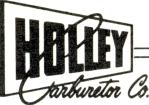
serves to open and close the power valve in accordance with engine power needs.
In the idle and normal cruising and Level operating range, when there are no great power demands placed on the engine, manifold vacuum from below the throttle plates is sufficient to hold the piston and stem up in the vacuum chamber against the calibrated strength of the spring. As the throttle plates are opened for high speed or heavy load conditions the vacuum below the throttle plates decreases. When this manifold vacuum diminishes to a predetermined level, the strength of the piston spring overcomes the decreased vacuum and forces the piston and stem down to depress the spring-loaded needle in the power valve. This allows the extra fuel required for high power operation to flow through the calibrated power valve into the main wellwhere itjoins with the fuel in the main metering system.
6. GOVERNOR SYSTEM
Carburetor Model 885-FFG series incorporate the Holley Centri-Vac vacuum operated engine speed governor. The governor consists of the two units, a throttle limiting mechanism which is attached to the throttle shaft of the carburetor and a separate controlling unit. The throttle limiting mechanism consists of a governor spring and a diaphragm which is exposed to carburetor vacuum. The spring and diaphragm are linked together by the governor lever which is attached to the throttle shaft of the carburetor. The controlling units consists of a rotor which is driven by the engine and contains a centrifugally operated governor valve.
Below governing speeds, the vehicle operator, through a simple dog clutch arrangement on the throttle body of the carburetor, controls the throttle plate and consequently, engine speed and power output, in the usual manner. When governing speed is reached, a combination of manifold vacuum and carburetor venturi vacuum acts on the governor diaphragm to close the throttle plates. Two calibrated by-pass jets in the vacuum passages meter the vacuum from the carburetor and the manifold to provide the correct balance for proper operation of the governor. At speeds below governing speed, this vacuum is weakened by air flowing through the governor valve so that no premature governing action will occur.
Filtered air from the carburetor air cleaner enters the governor system through the governor vent tube. The air flows through an air line to
the housing enclosing the governor rotor. Governor vacuum draws the air past the governor valve and through another airline to the throttle limiting unit on the carburetor.
When governing speed is reached, centrifugal force acting on the rotor, which has kept pace with engine speed, overcomes the tension of the valve spring and tends to close the governor valve. This greatly restricts the amount of air bleeding through to the diaphragm on the carburetor, thus allowing the combined carburetor and manifold vacuum to operate the diaphragm. As the vacuum acting onthe diaphragm increases, the diaphragm moves the governor lever against the tension of the governor spring to close the throttle plate.
The governed engine speed is held constant by centrifugal force on the valve balancedagainst the tension of the valve spring. Any slight change in engine speed will cause the governor valve to act immediately to either increase or decrease the amount of air bleeding through the governor valve orifice. A change in the amount of air bleed will, in turn, cause an instant response from the diaphragm to increase or decrease the throttle plate opening. When the accelerator is released, control is taken from the governor by the external throttle lever and the return spring in the accelerator pedal linkage closes the throttle plate to bring the engine to any desired lower speed.
7. AUTOMATIC CHOKE SYSTEM
The automatic choke is a device to aid the starting and running of a cold engine. When starting a cold engine, much of the atomized fuelfrom the carburetor condenses to a liquid on contact with the cold surface of the intake manifold. The fuel in liquid form burns too slowly in the cylinders, causing a loss of power and stalling. The choke is a means of enriching the fuel discharge so that enough vaporized fuel reaches the cylinders to permit the engine to run smoothly during the warm-up period.
When the temperature of the bi-metallic thermostat spring is below 70 degrees, it holds the choke plate in the fully closed position.
When the engine starts, air impact immediately acts on the offset choke plate, forcing it to a partially open position to prevent stalling. Manifold vacuum is channelled through a passage in the throttle body and air horn, acting on the choke vacuum piston to further open the choke plate, thus allowing the engine to develop sufficient